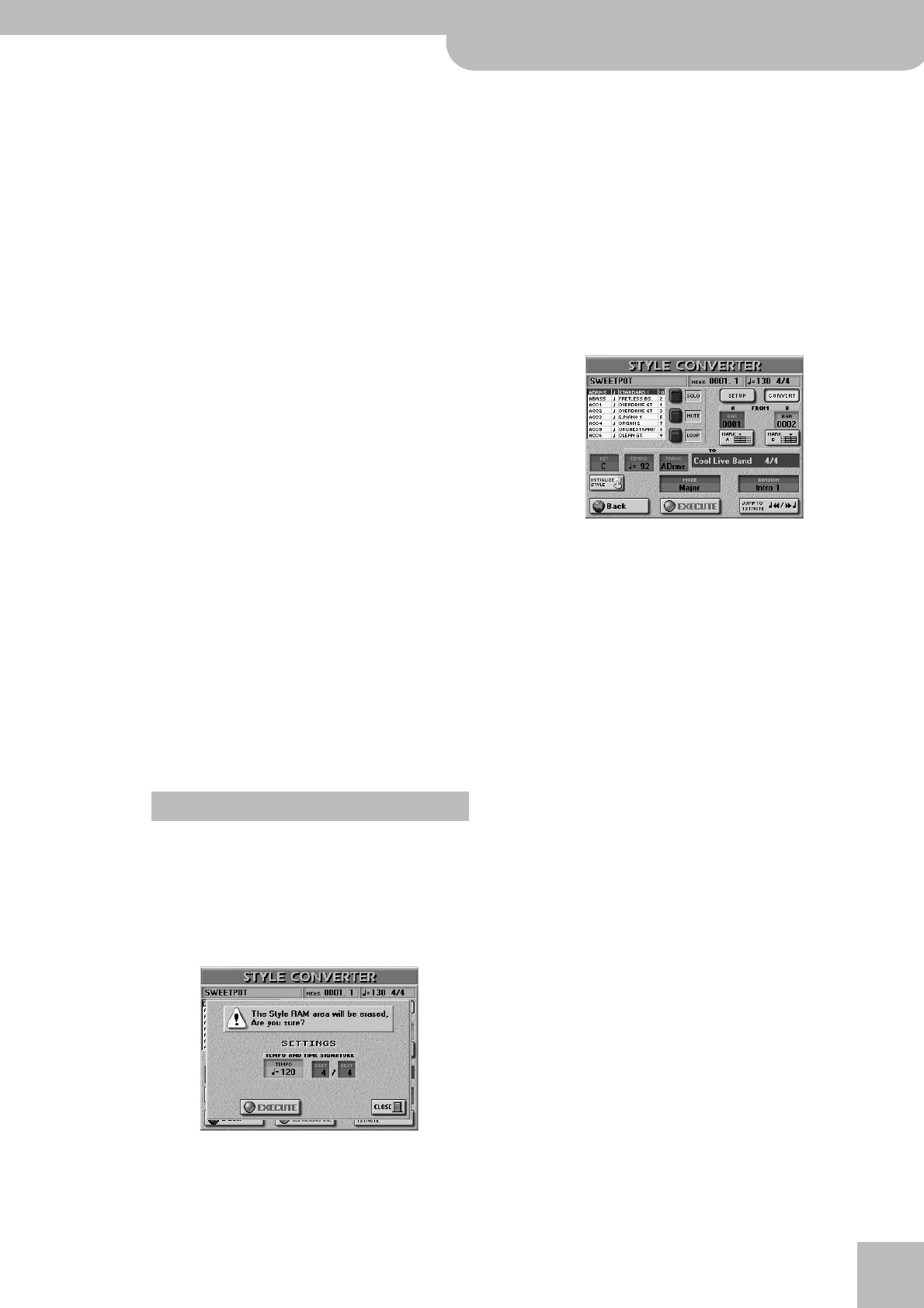
Style Converter
E-80 Music Workstation
r
199
Here, you can listen to the selected tracks, specify
which excerpt should be extracted and set the pat-
terns that should contain the selected data. The most
logical order for proceeding is as follows:
(7) Press the RECORDER [TOP¥|√] button, followed by
[PLAY÷STOP¥®÷ª] to start song playback.
[FWD] and [BWD] are also available for rewinding and
fast-forwarding.
(8) While listening to the song, press the [MARK¥A]
field at the beginning of first measure to be con-
verted, and [MARK¥B] when the E-80 reaches the
last measure you need.
Alternatively, you can stop playback, press the FROM
[A] or [B] “display” field and enter the measure num-
ber with the [DATA÷ENTRY] dial or the [DEC]/[INC]
buttons.
(9) Stop playback by pressing [PLAY÷STOP¥®÷ª].
(10) Switch on the [LOOP] button icon.
This function allows you to listen to the selected
excerpt (between [A] and [B]) repeatedly.
That way, you can check whether the last notes of
your pattern-to-be allow for a smooth transition to
other Music Style patterns, or sound natural when
the pattern is repeated. Sometimes, quantizing the
last few notes of an excerpt may be helpful to avoid
including notes that were played a little ahead of the
beat (and therefore sound on the last beat you con-
vert). See page 180 for details.
(11) Press the RECORDER [PLAY÷STOP¥®÷ª] button to
start playback.
The selected passage is repeated over and over until
you stop playback.
(12) If necessary, use the [MUTE] and [SOLO] fields to
temporarily switch off or isolate certain tracks.
This is only for checking purposes. The on/off status
does not affect the selection that will be converted.
The [INITIALIZE¥STYLE] field on this page is usually
used only once: before converting the first song
tracks. If you don’t use this field, the tracks you con-
vert are added to the Style data already present in
the E-80’s Style RAM area. If you need to start from
scratch, however (to create an entirely new Style)…
• Press the [INITIALIZE¥STYLE] field.
• Press the [TEMPO] and use the [DATA÷ENTRY] dial or
the [DEC]/[INC] buttons to enter the desired value.
• Press the two TIME SIGNATURE fields (one after the
other) and use the [DATA÷ENTRY] dial or the [DEC]/
[INC] buttons to enter the desired value.
Note: This is your first and last chance to specify the new
Style’s time signature. The only way you can do this is by ini-
tializing the Style RAM area. So be sure to set this value before
your very first conversion. (The Style’s time signature can also
be changed using the Style Composer, however, but that forces
you to change modes.)
• After setting everything to your liking, press the
[EXECUTE] field to initialize the Style RAM area.
(Press [CLOSE] to leave this page without initializing
the data in RAM.)
This takes you back to the “CONVERT” page:
(13) Now select the destination pattern, i.e. specify
whether the selected excerpt should become a
MAIN pattern, an Intro, etc.
(14) Press the available “display” fields and use the
[DATA÷ENTRY] dial or the [DEC]/[INC] buttons to
enter the desired value.
The parameters discussed below can be set for each
track and pattern individually. Though flexible, this
system also means that you need to be careful so as
to achieve usable results.
● Key—(C, C#, D, Eb, F, F#, G, Ab, A, Bb, B) Use this parame-
ter to tell your E-80 what key the track (or tracks) is (or
are) in. Specifying the right key before converting the
data is crucial for real-time use of a pattern. The chord
recognition system of the Arranger is indeed based on
the assumption that all patterns are in the key of C.
Thus, whenever you play a C (in INTELLIGENT mode) or a
C chord in the chord recognition area, the E-80 uses the
original notes of the pattern (no real-time transposition).
If that pattern is in F# and if you forgot to tell the E-80
that it is, F# is what you will hear when you play a C or C
chord.
Note: There is no need to specify the key for ADR tracks.
● Tempo (20~250)—Allows you to specify the default
tempo of the Music Style.
● Track (ADrum, ABass, ACC1~6, ALL)—This is where you
can specify the tracks that should be extracted and
turned into a Music Style phrase. In most instances, you
will probably select “ALL”. You could, however, also
extract each track separately.
Initializing the Style RAM memory


















